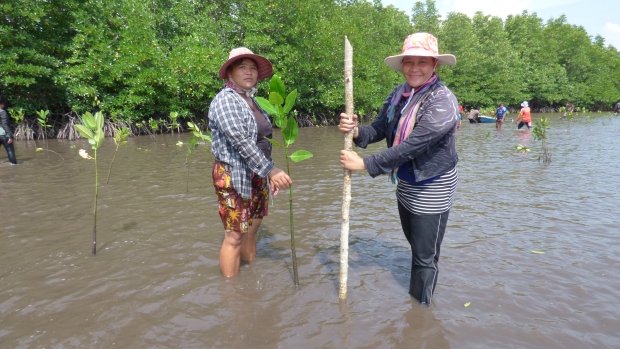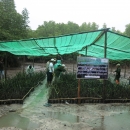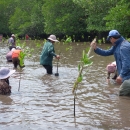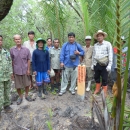Grants :: Small Grant Facilities :: Participation in protecting and conserving mangrove forest resources to improve local livelihoods and adapt to climate change, Tuol Korki Community Protected Area
Participation in protecting and conserving mangrove forest resources to improve local livelihoods and adapt to climate change, Tuol Korki Community Protected Area

Women planting mangroves © MFF Cambodia, 2016.
Objectives
To ensure the sustainable management of mangrove forest resources and biodiversity ecosystem to improve the livelihood of local community and climate change mitigation.
Background
Mangrove forests in Cambodia are under threat from both nature and human activity. Currently, illegal logging of mangroves by people in and outside the local community is evident in Peam Krasop Wildlife Sanctuary and Toul Koki community protected area. Those mangrove trees were used to build houses, converted to charcoal, other beneficial uses and also sold to domestic and external markets without proper regulations. The understanding of community members about the value of mangrove forests, and the involvement of local authorities and relevant stakeholders related to mangrove forest management is still limited. The project focused on raising awareness of local people about the value of mangrove ecosystems and biodiversity within mangrove forests and to involve them in the conservation of 520 ha and restoration of 10 ha of degraded mangrove forest.
Target beneficiaries
Target beneficiaries of the project are 200 households in Toul Koki community with a total of 1,000 members and 100 students from 2 target schools.
Outputs
There are three expected results:
- 200 households of 4 target villages will understand the importance of mangrove forest and biodiversity ecosystem as well as relevant laws.
- 520 ha of existing mangrove forest and biodiversity ecosystem within the forest will be restored.
- At least 200 households of 4 target villages and 100 students of 2 target schools will obtain knowledge and technical skills in nursery and planting mangroves.
Accomplishments and challenges
Accomplishments
- Four mangrove nurseries were built by MFF-funded project. 42,000 saplings were produced in the four locations of nurseries.
- 25,000 mangrove seedlings were planted on the 10 hectares of mangrove degraded areas.
- Four 80cm x 120 cm signboards were produced and erected at the mangrove nurseries.
- 92 families were educated about fisheries law and law on protected areas with the participation from the department of environment and fisheries administration cantonment.
- 36 of 50 CPA boundary cement posts were already installed to clearly indicate the boundary of CPA to the public, especially local people.
- 6 signboards were erected close to the main walking road.
- Patrolling activities are regularly conducted.
- Education/outreach activities were conducted to increase the importance of the boundary of CPA, relevant laws on environment and protected area law.
Challenges
- Capacity of Tuol Korki Community Protected Area is still limited in terms of knowledge about mangrove ecology;
- CPA planted mangrove saplings with the plastic bags which may cause the slow growth.
Contributions to cross-cutting themes
- Climate change
- Raise awareness and educate local community and relevant stakeholder about the value of mangrove ecosystem
- Protect and conserve the existing mangrove forest in community and restore the degraded forest.
- Gender
- Both male and female of 200 households will receive benefit from project equally. During project implementation, most of women will play an important role in all activities of project implementation.
- Communication
- Strengthening cooperation and communication between existing networks in local level to national level.
- Disseminate the information and knowledge about advantages of mangrove forest and biodiversity ecosystem and climate change via conducting workshop, meeting, and media programs and so on.
Lessons Learned
- Direct setting of mangrove seeds is more cost effective than the saplings produced from the nursery if seeds from the wild are properly selected.
- Engaging local people, especially women in collecting and planting mangrove seeds is very important to ensure full participation and ownership;
- Building local partnerships with the department of environment is important to ensure that technical assistance is sufficiently provided
Project Facts
Country
Location
Tuol Korki Community Protected Area
Topic
Duration
1st May 2015 to 30th Apr 2016
MFF Grant Amount
99,727,000 KHR
Co-financing Partner
Toul Koki Community Protected Area Commitee
35,925,000 KHR (in kind)
Implementing Partner
Toul Koki Community Protected Area Commitee


